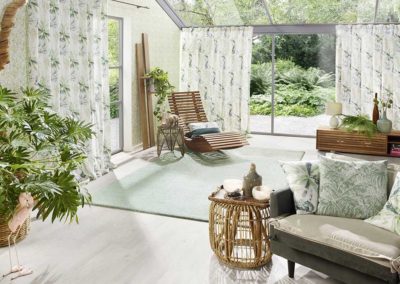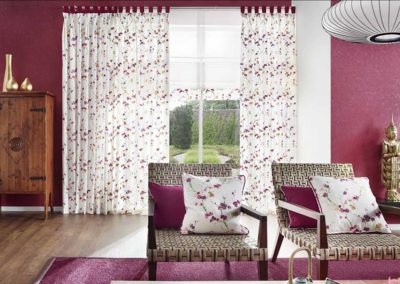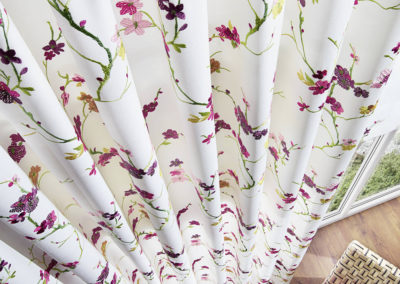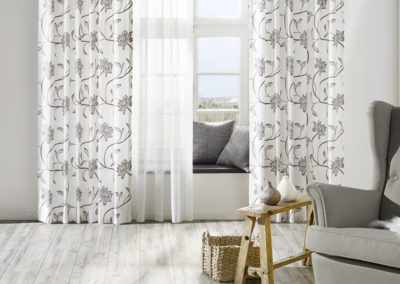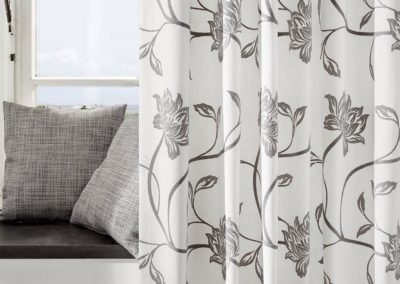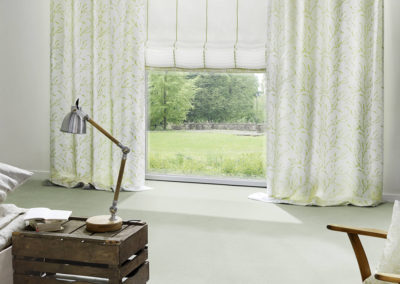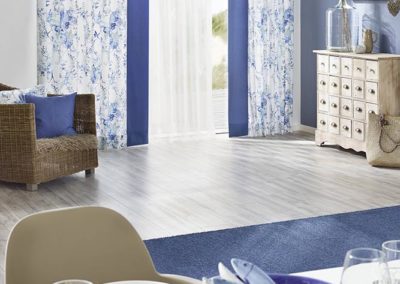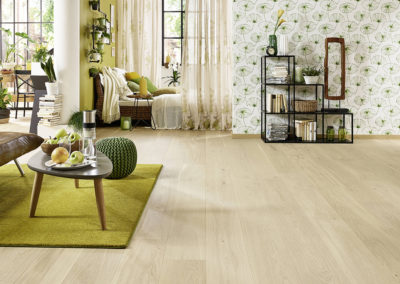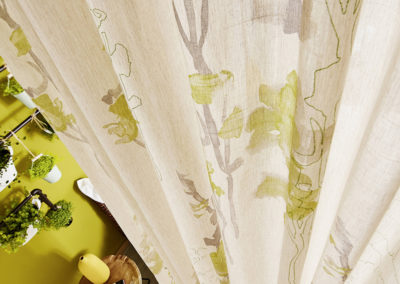Curtains
Modern curtains for a cosy atmosphere
Curtains, also known as drapes or blinds, are not only a practical item that protects us from light, noise and prying eyes, but also an important part of interior design, as curtains influence the style, colour, acoustics and atmosphere of a room. It is therefore very important to choose a curtain in the right colour, pattern, fabric thickness (with Dimout the curtain even darkens completely) and length in the showroom. Once the fabric has been selected, we can cut and sew the exact dimensions in our in-house sewing shop and, if required, also install them.
Our master interior decorator Lucas has worked a lot with curtains since the beginning of his career and is a complete professional in this field. He furnishes countless hotels with new curtain collections every year and will be happy to advise you on your new project free of charge.
In the Showroom you can choose between classic and modern patterns and colours. You can also choose the fabric thickness, transparency and material to suit your individual taste. From the popular dimout curtain to trendy thread curtains, there is something for everyone.
Exclusive curtains in classic, modern or extravagant patterns and colours give your living space that certain something.
But how do you choose the right curtains?
Choosing the right curtains depends on various factors, such as the purpose of the room, the size and shape of the windows, the available light, the desired style and the budget. Here are some questions you can ask yourself before deciding on curtains at Bodenstudio:
- What function should the curtains fulfil? Do you only want to use the curtains as a decorative element or should they also have a practical use, such as darkening the room, dampening noise or creating privacy? Depending on what function you are looking for, you can opt for different materials, colours and patterns. For example, heavy, dark and dense fabrics such as velvet, brocade or chenille are ideal for the bedroom as they shield the light well and create a cosy atmosphere. Light-coloured, light and transparent fabrics such as cotton, linen or silk, on the other hand, are more suitable for the living room as they let the light through and have an airy and fresh effect.
- How big are the windows? The size and shape of the windows influence the length, width and arrangement of the curtains. As a rule of thumb, the curtains should start at least 15 cm above the window frame and end at least 15 cm below the window sill. If you want the curtains to hang down to the floor, you should leave a gap of around 2 cm between the curtain and the floor. Another option is an overlying curtain. The width of the curtains should be at least 1.5 times the width of the window so that they fall nicely and don't look too narrow. If you have several windows next to each other, you can either choose a separate curtain for each window or a long curtain that covers all the windows. If you have a particularly large or unusually shaped window, you can also order customised curtains that fit your window perfectly.
- How much light enters the room? The amount and quality of light coming into the room can influence the colour and pattern of the curtains. If you have a room that gets a lot of natural light, you can opt for bright and vibrant colours that reflect the light and brighten up the room. If you have a room that gets little or no natural light, you can opt for warm and muted colours that make the room cosier and more inviting. You should also make sure that the colour of the curtains doesn't clash or contrast too much with the colour of the walls or furniture. If you're unsure which colour to choose, you can always opt for neutral tones such as white, beige, grey or black, which go with almost any interior style. If you want a little more variety, you can also opt for single-coloured curtains with an interesting pattern, such as stripes, dots, flowers or geometric shapes. In the Bodenstudio showroom, we have all collections on display, whether trendy, modern or classic. We also have some very exclusive "scarves" on display.
What types of curtains are there? There are many different types of curtains that vary in shape, style and fastening. Here are some of the most common curtain types that you may already be familiar with:
- Loop curtainsLoop curtains are curtains that have loops at the top through which a curtain pole is pulled. They are easy to install and remove and have a casual and uncomplicated look. They are well suited to rooms that have a relaxed and cosy atmosphere, such as the bedroom or children's room. Loop curtains are usually made from light and flowing fabrics and let in plenty of light.
- Eyelet curtainsEyelet curtains are curtains that have metal or plastic rings at the top through which a curtain pole is pulled. They are also easy to install and remove and have a modern and elegant look. They are well suited to rooms with a simple and stylish atmosphere, such as the living room or dining room. Eyelet curtains are usually made of heavy and smooth fabrics and block out more light than loop curtains.
- Track curtainsTrack curtains are curtains that are attached to a track that is mounted on the ceiling or wall. They are a little more difficult to install and remove, but they have the advantage that they do not require a curtain pole and therefore save more space. They are well suited to rooms that have a minimalist and functional atmosphere, such as the office or bathroom. Track curtains are usually made of thin and smooth fabrics and let little light through.
- Roman blindsRoman blinds are curtains that are attached to a roller at the top of the window. They can be pulled up and down with a drawstring or chain, depending on how much light or visibility you want. These types of curtains are very popular and are particularly suitable for single households as they look young and modern. They are also easy to use on kitchen windows - they can be pulled up quickly when required. Roman blinds are usually made of firm and decorative fabrics such as linen and sometimes have frills or lace as decoration.
How do you care for curtains? Curtains are not only a beautiful eye-catcher, but also an important protection against dust, dirt and sunlight. To keep them clean and beautiful for a long time, they should be cleaned and maintained regularly. Here are some tips on how to care for curtains properly:
- Dusting: Curtains should be dusted at least once a week with a hoover or feather duster to remove dust and dirt. You should work from top to bottom and make sure you get all the creases and corners.
- Washing: Curtains should be washed every three to six months, depending on the material and degree of soiling. You should always follow the manufacturer's care instructions, which can be found on the label. Some curtains can be washed in the washing machine, others must be washed by hand or taken to a dry cleaner. If you wash the curtains in the washing machine, you should use a mild detergent, reduce the spin speed and pack the curtains in a laundry bag or pillowcase to protect them from damage. If you wash the curtains by hand, use lukewarm water, do not wring or rub the curtains and spread them out flat to dry. If you take the curtains to the dry cleaner, make sure that they are dry-cleaned and not just mechanically cleaned to remove stains and odours.
- Drying: Curtains should always be air dried, never tumble dried, as they can become damaged or creased. They should be hung as flat as possible to avoid creases. If the curtains are still damp, they should be hung on the windows again and pulled into shape. If the curtains are already dry, they should be ironed or steamed before hanging to smooth out creases. Always adjust the ironing temperature to the material and iron the curtains on the reverse side or with a cloth in between to avoid burning.
- RefreshCurtains can fade in the sun and absorb odours from the room. To counteract this effect, they should be freshened up from time to time. To do this, you can spray them with a fabric freshener, which neutralises unpleasant odours and leaves a pleasant fragrance. You can also put a few drops of essential oil on a cotton wool pad and place it near the curtains to create a natural and aromatic scent. You can also heat the curtains slightly with a hairdryer or steam iron to loosen the fibres and give them more volume.
FAQ - Frequently asked questions about curtains
How do you wash curtains properly?
You should wash your curtains every few months. Hanging them just before washing prevents the fabric from creasing too much. To remove the coarsest dirt and dust before washing, the curtain can be shaken out first.
Curtains are easy to wash in the washing machine. Caution - curtains should never be tumble dried! Not only can this damage the fabric, it can also lead to unsightly creases. It is better to hang the curtains up damp and allow them to air dry.
Which programme should I use to wash curtains?
As the fabrics are usually more delicate, they should be washed at a maximum of 30 degrees if there are no washing instructions. A delicate wash programme with a low spin speed is ideal. To be on the safe side, it is advisable to use a mild detergent.
How do I make the curtains fall beautifully?
A pleated tape is best suited. This creates even folds at the top when the fabric is pulled together. If this is not available, you can also use pins to help. Place the pins in a pleat at the top and bottom of the fabric and pin in place. You can remove the pins as soon as the fabric has unhooked.
How far should the distance to the floor be?
There is no such thing as the right curtain length! But we do have tips on how to optimise the effect of curtains. Just a few centimetres difference can make all the difference.
In the past, curtains were almost always sewn at floor length. This allowed the fabric to fall straight and elegantly. The fabric almost lies on the floor and only has a gap of one to two centimetres to the floor. The floating curtain is ideal for frequently used rooms as they are practical and easy to maintain.
The curtains can also rest on the floor, but they should be cleaned thoroughly so that they do not inadvertently become a dust mop. Curtains that are only one to two centimetres too long are referred to as broken curtains.
The fabric stands up slightly at the bottom, causing the curtain to fan out and appear wider. Significantly longer curtains gather at the bottom and create an opulent look.
For window sills, it is practical to keep the curtains short and cut them so that there is some air between the window sill and the curtain.
Customer testimonials
.


